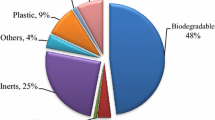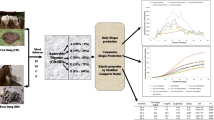Abstract
Anaerobic digestion is the most attractive technique for biogas production from organic materials. This research studies and models such production from anaerobic digestion of tomato processing wastes in a single-stage laboratory digester and the variation of pH of the process. The single-stage digester was designed and built on a laboratory scale and the tomato processing wastes used as feed materials for digestion were collected from the Zoshk Khorasan Company (Mashhad-Iran). Some properties of digested materials were determined. The results revealed that the tomato processing wastes could be an appealing option for production of biogas by anaerobic digestion process. The digester was controlled under mesophilic conditions (35 °C) with continuous mixing. Also, the percentage of total solids content was adjusted 8%. The amount of production of biogas from the waste was approximately 142.00 L (130.00 L in STP conditions) which is equivalent to 0.14 m3 per kilogram of volatile solids (m3/kg vs). The methane content in the produced biogas was approximately 60.50% (about 86.00 L).






Similar content being viewed by others
References
Jury C, Benetto E, Koster D, Schmitt B, Welfring J (2010) Life cycle assessment of biogas production by monofermentation of energy crops and injection into the natural gas grid. Biomass Bioenerg 34:54–66
Kim DH, Oh SE (2011) Continuous high-solids anaerobic co-digestion of organic solid wastes under mesophilic conditions. Waste Manage 31:1943–1948
Richter F, Fricke T, Wachendorf M (2011) Influence of sward maturity and pre-conditioning temperature on the energy production from grass silage through the integrated generation of solid fuel and biogas from biomass (IFBB): 1. The fate of mineral compounds. Biores Technol 102:4855–4865
Rao PV, Baral SS, Dey R, Mutnuri S (2010) Biogas generation potential by anaerobic digestion for sustainable energy development in India. Renew Sustain Energy Rev 14:2086–2094
Arbabi M, Omrani QA (2011) Biogas technology. Fanavaran, Tehran
Taleghani G, Kia AS (2005) Technical–economical analysis of the Saveh biogas power plant. Renew Energy 30:441–446
Fazli F (1986) Biogas in China. Ministry of Planning and Budget, Tehran
Jiang X, Sommer SG, Christensen KV (2011) A review of the biogas industry in China. Energy Policy 39:6073–6081
Arthur R, Baidoo MF, Brew-Hammond A, Bensah EC (2011) Biogas generation from sewage in four public universities in Ghana: a solution to potential health risk. Biomass Bioenergy 35:3086–3093
Ossai OS (2013) Comparative evaluation of qualitative and quantitative biogas production potential of oil palm fronds and co-digestion with cow dung. J Energy Technol Policy 3:25–33
Kurmanov A (2014) The biogas production effectiveness increase. Life Sci J 11(11s):24–29
Mshandete A, Björnsson L, Kivaisi AK, Rubindamayugi MS, Mattiasson B (2006) Effect of particle size on biogas yield from sisal fibre waste. Renew Energy 31:2385–2392
Singh S, Prerna P (2009) Review of recent advances in anaerobic packed-bed biogas reactors. Renew Sustain Energy Rev 13:1569–1575
Christy PM, Gopinath L, Divya D (2014) A review on anaerobic decomposition and enhancement of biogas production through enzymes and microorganisms. Renew Sustain Energy Rev 34:167–173
Coskun C, Bayraktar M, Oktay Z, Dincer I (2012) Investigation of biogas and hydrogen production from waste water of milk-processing industry in Turkey. Int J Hydrog Energy 37:16498–16504
Sarada R, Nand K (1989) Start-up anaerobic digestion of tomato-processing wastes for methane generation. Biol Wastes 30:231–237
El-Shimi S, El-Housseini M, Ali B, El-Shinnawi M (1992) Biogas generation from food-processing wastes. Resour Conserv Recycl 6:315–327
Saev M, Koumanova B, Simeonov M (2009) Anaerobic co-digestion of wasted tomatoes and cattle dung for biogas production. J Univ Chem Technol Metall 44:55–60
Federation WE, Association A (2005) Standard methods for the examination of water and wastewater. American Public Health Association (APHA), Washington, DC
Forster-Carneiro T, Pérez M, Romero L, Sales D (2007) Dry-thermophilic anaerobic digestion of organic fraction of the municipal solid waste: focusing on the inoculum sources. Bioresour Technol 98:3195–3203
Zennaki-Bensouda Z, Zaid A, Lamini H, Aubineau M, Boulif M (1996) Methane fermentation of cattle manure: effects of hydraulic retention time, temperature and substrate concentration. Tropicultura 14:134–140
Dueblein D, Steinhauser A (2008) Biogas from waste and renewable resources. Wiley-VCH Verlag GmbH and Co 276, KGaA
Zhang C, Su H, Baeyens J, Tan T (2014) Reviewing the anaerobic digestion of food waste for biogas production. Renew Sustain Energy Rev 38:383–392
Gerardi MH (2003) The microbiology of anaerobic digesters. In: Gerardi (ed) Wastewater microbiology series. Wiley, Hoboken, NJ
Omrani G (1996) Basics biogas production from urban and rural waste. University of Tehran Publication, Iran
Acknowledgements
The authors would like to sincerely thank the senior management and staff of Laboratory of Recycling Organization of Mashhad Municipality. And the authors sincerely thank Dr. Abedini, Mr. Aryan Nejad and Mr. Hassan Nejad.
Author information
Authors and Affiliations
Corresponding author
Rights and permissions
About this article
Cite this article
Saghouri, M., Mansoori, Y., Rohani, A. et al. Modelling and evaluation of anaerobic digestion process of tomato processing wastes for biogas generation. J Mater Cycles Waste Manag 20, 561–567 (2018). https://doi.org/10.1007/s10163-017-0622-4
Received:
Accepted:
Published:
Issue Date:
DOI: https://doi.org/10.1007/s10163-017-0622-4




